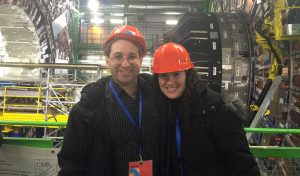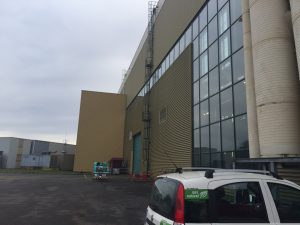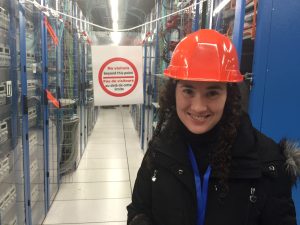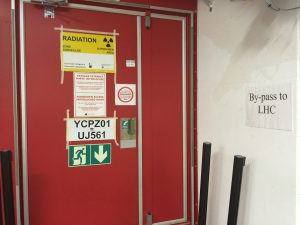BQP/LHC collision
This afternoon, I gave my usual spiel about Quantum Computing and the Limits of the Efficiently Computable at the CERN Colloquium. (If you watched the webcast of the Higgs boson discovery announcement a couple years ago, it was in the same auditorium they used for that, except this time it was less packed.) Beforehand, Dana and I got to join a tour of the CMS detector at the Large Hadron Collider—one of the very last tours, before CMS shuts down (as ATLAS already has) to get ready for collisions at the LHC’s new, higher energy.
Considered as eye candy, I’d say that the CMS detector holds its own against the Taj Mahal, Machu Picchu, the Great Wall of China, or any of the other engineering marvels of the world. So, OK, let me describe what it’s like to visit it. The first step is to take a tram from downtown Geneva to CERN, which is headquartered in the town of Meyrin. This is easier than you’d imagine: a tram actually arrives in Geneva every few minutes with “CERN” (its final stop) written right on it! Next you take a 20-minute bus ride from the CERN reception hall to the CMS building, which is across the French border. You don’t really think about it until you’re here, but:
(a) The Large Hadron Collider is large—it’s, like, a whole drive through the countryside to get from the main CERN buildings to CMS.
(b) All inside the LHC ring is just a normal rural/suburban area, with restaurants, roads, gas stations, cows, etc.
Anyway, then you arrive at CMS, which looks from the outside like just a big warehouse-type building.
And you go inside, wondering if now you’re going to see the detector. But no, there’s just a giant tarp hanging from the ceiling with a picture of the detector on it. Maybe this tour won’t include the detector?
But then you go outside, back in through some back entrance, then into a staging area where you get hard hats to wear. Then you get into an elevator that goes about 150 feet down. Meanwhile, your tour guide is carrying a geiger counter to make sure you’re not exposed to too much radiation. Now will you see the detector? No, just a bunch of dark corridors. You pass through a room full of computers on racks—cool, this must be where they analyze the collision data! (Actually, according to Panflutist in the comments section, these computers are only for control and for the trigger system, which decides which events to store for later analysis.)
Then, after that room, there’s a door with a sign indicating that beyond it is the LHC ring. Cool!
Of course, you’re not actually going into the ring. But then you turn a different way, and emerge onto a platform where you to get to the “big reveal”: the detector, two giant circular pieces that obviously screw together but are now separated, and engineers making final tweaks to them before they’re reunited for the next collider run. (I forgot to mention: the whole tour is being conducted in French. That’s why you sort of need to guess what’s happening.)
Anyway, thanks so much to Wolfgang Lerche and everyone else at CERN for an awesome visit.





 Follow
Follow
Comment #1 January 15th, 2015 at 4:31 pm
Thanks for your talk Scott, I enjoyed it very much. Also I’m a CMS guide and I would’ve given you a tour in English if you had asked *grin*
The rack computers downstairs don’t actually do physics analysis but operational/control work. The trigger system comes closest to doing physics analysis — it is basically a crude but superfast filter that makes sure only interesting collision events make it to permanent storage and later physical analysis.
Comment #2 January 15th, 2015 at 6:40 pm
While it is clear why you need something that “makes sure only interesting collision events make it to permanent storage and later physical analysis.”; one naturally worries that results due to undreamed of phenomena might be getting tossed.
Does anyone know if this is possible?
It would be interesting to occasionally record every single event for a while, and analyze each one to see how closely the assumptions about the unwashed multitudes bear out.
Comment #3 January 15th, 2015 at 7:36 pm
You can visit Paris without knowing a word of French, but not the LHC. Thank you CERN for a fierce defense of our language! 🙂
Comment #4 January 15th, 2015 at 10:27 pm
Panflutist #1: Thanks!! I updated the post.
Serge #3: There exist English tours as well, but this is what they were able to find for us on short notice (and after CMS was supposed to be closed to visitors), so we gratefully accepted! Also, Dana has a few years of high-school French (whereas with me it’s mostly bonjour, merci, oui, baguette).
Comment #5 January 15th, 2015 at 11:39 pm
Oh boy, now the LHC engineering team will have literally weeks of experimental troubles! The Pauli effect… 🙂
Comment #6 January 15th, 2015 at 11:48 pm
#2: The trigger system (along with the first rounds of filtering occurring at the hardware level) cuts down on the number of collected events by many orders of magnitude (I’ve seen values of around 10^5 to 10^6, though I don’t know the details) before the data moves further down the pipeline and into permanent storage. I don’t think CERN (or anyone else) has the infrastructure to handle that kind of increase in the data collection rate; the aggressive filtering is really necessary. (A lot of the uninteresting events are low-energy collisions, which are relatively well-understood and not as useful for the LHC’s goals.)
I think particle physics theorists and phenomenologists do worry about interesting events getting past the trigger system. I hope someone more knowledgeable than me can say more about this — my experience with particle physics data analysis was much farther down the pipeline.
Comment #7 January 16th, 2015 at 3:19 am
Cool post!
As far as I know, collision data are filtered (to reduce their size) and analyzed by means of a worldwide grid computing facility (I remember the middleware they used was gLite (http://grid-deployment.web.cern.ch/grid-deployment/glite-web/), but now there is a new initiative called EMI (http://www.eu-emi.eu).
Panflutist, can you tell some more about this?
Comment #8 January 16th, 2015 at 6:33 am
Great post, you lucky man! Totally agree with the comparison to the other great engineering wonders of the world, only wish more people would realise the crazy beauty of what CERN has achieved.
Comment #9 January 16th, 2015 at 9:43 am
Nice!
Was this a tour available to the general public too or something they did just for you as a special guest?
Comment #10 January 16th, 2015 at 1:54 pm
milestone! 1st picture of your wife on this blog? a bit envious of your cool trip. its neat/ great to see Big Science still thriving in the world even after the US space program has been seriously downsized. oh yeah and then theres the old american politics of the US supercollider. ouch.
but one wonders if there is a way to spend those countless billions on the supercollider on computational simulations somehow.
btw did you ever see that great movie Particle Fever re LHC/ Higgs? cant recall if you covered it in your blog. some coverage on that here wrt a cool Higgs datamining competition that concluded.
Comment #11 January 16th, 2015 at 2:04 pm
fred #9: It was a tour for a bunch of people. If it were just for us, presumably they would’ve done it in English. 🙂
vzn #10: No, I posted a photo of Dana from our honeymoon in Kenya, and another from when Lily was born. And yes, I blogged my (extremely positive) thoughts about the Particle Fever movie here.
Comment #12 January 16th, 2015 at 2:21 pm
Michele #7: It looks like you know more about the grid than I do, but yes there is a worldwide LHC grid for storage and analysis of the data.
fred #9: Public tours are available and although they don’t *guarantee* an underground visit I would expect it to be included. It may be easier to find a guide and ask them than to go through the official visits service. I don’t know if I should be careful saying this sort of thing on a public forum, but you may have luck asking in /r/CERN on Reddit. Unfortunately the underground experimental caverns of ATLAS and ALICE are closed to visitors now and LHCb and CMS will close mid February. They will be closed for three years for the second LHC run.
Comment #13 January 16th, 2015 at 2:48 pm
Matt Strassler (profmattstrassler.com) has a lot of pretty accessable discussion of LHC triggering strategies, and the risks of missing interesting phenomena, on his blog.
Comment #14 January 16th, 2015 at 7:20 pm
Just to clarify the trigger issues. It is true that theorists and not only them worry about the trigger (the 3 levels of them).
But I’d like to say that the trigger is not only 1.
There are several logic conditions connected by an “OR” that let events go through. For example:
A: An event with a high energy muon
B: An event with at least X GeV total energy in the calorimeter
C: etc etc….
The trigger is then A OR B OR C etc…
If the trigger were just 1 condition then one would really worry.
Anyway, the trigger conditions evolve in time with technology, speed of the chips, level of pileup (linked to LHC luminosity), physics studies and requirements etc etc.
K.
Comment #15 January 18th, 2015 at 3:58 am
“Meanwhile, your tour guide is carrying a geiger counter to make sure you’re not exposed to too much radiation.”
May I ask: is there really a danger from cascade reaction products so far from the beam line? Or is the source of radiation from something else?
Comment #16 January 18th, 2015 at 2:30 pm
The thing they carry is not technically a geiger counter but a dosimeter. You wear it when you work in a radiation area and it keeps track of your exposure. Every month you have it read out by a machine so that your annual exposure is known (this is required by Swiss and French law to be below some limit).
So the dosimeter is for the safety of the guide, not the visitors. 🙂 The visitor itinerary and especially the visitor balcony in the experimental cavern are closely monitored by Radiation Protection. This allows them to be declassified as radiation areas and accessible to the public.
But yes, there is very little radiation in the cavern now. What little there is is decay radiation due to activation of the detector materials. E.g. neutrons produced in a collision can be captured by atoms in the detector. Most of the materials are chosen to be radiation-hard, but things like steel screws and copper wiring are hard to control and prone to activation. And it’s just a harsh environment in there.
Of course operation stopped two years ago and the detector has had time to “cool down”. But regulation at CERN is strict; basically any room that has ever had a beam in it is considered a radiation area. Also anything that has been in a room with beam is considered radioactive until proven innocent.
Comment #17 January 18th, 2015 at 8:35 pm
I would love to get a rundown on the computing architecture used in CMS and ATLAS to capture and store all the data from experiments. It certainly puts the capital B in Big Data. Is that information available online somewhere or is it proprietary?
Comment #18 January 20th, 2015 at 5:22 am
Too bad we can’t just factor numbers by accelerating them towards each other at great speeds.
Or maybe we can…
Comment #19 January 20th, 2015 at 8:26 am
Darrel,
You can find information about some of those stages here
http://wlcg-public.web.cern.ch/
Comment #20 January 20th, 2015 at 12:32 pm
Job #18: But fortunately, we can’t just break atoms by shaking them together at normal speed for a long time! 🙂
Comment #21 January 20th, 2015 at 9:42 pm
@Job18 “Too bad we can’t just factor numbers by accelerating them towards each other at great speeds.”
I think it should certainly be possible one day to reason about a fundamental amount of required energy to factor a number into its prime components (with some reasoning based on Landauer’s principle). And that would be satisfying in the same sense? However, I have no idea when such a day will arrive.
Comment #22 January 21st, 2015 at 8:55 pm
It sounds absurd, but in a different context we might be asking about the force which holds a composite number together.
After all, a composite number doesn’t simply decay into its prime factors – the decomposition process has some energy requirements. What’s holding it together? 🙂
If we interpret the mass of a number as its bit count, then the force holding two primes together into a composite number is kind of like gravity, only stronger.
The prime force, measured in Hz is roughly given by the expression:
f(p1, p2) = 2^(mass(p1) + mass(p2)) Hz
Though i’m sure we could do alot better than that.
Comment #23 January 24th, 2015 at 12:39 pm
The analogy of factoring and particle decay is interesting. Hard to guess if it will have legs. Does anyone know if this analogy has been thought of or published before this SO thread? If not, the beginnings of a new theory might have an unusually well documented genesis! 🙂
How about a name for the subject area of oddball analogies between central concepts of Physics, Math, CS, etc?
Comment #24 January 24th, 2015 at 2:53 pm
Raoul,
The original analogy was actually mine:
https://rjlipton.wordpress.com/2012/05/12/quantum-refutations-and-reproofs/#comment-20771
For me, the only difference between a computer and a collider is that the computer deals with information instead of kinetic energy. I now view the atom as a sort of running computer, with the nucleus representing the hardware and the electrons representing the software – the different layers of electrons ranging from the operating system to the application programs.
I think it’s possible to view processes as a continuation of the organization of matter. Hence there isn’t a real qualitative difference between matter and spirit – just a series of quantum leaps. Also, it’s a quantum leap that separates P from NP rather than an equal or unequal sign. So let’s start using probabilities in complexity theory too!
Comment #25 March 9th, 2015 at 11:24 am
Meanwhile, at LEGO… https://ideas.lego.com/projects/94885